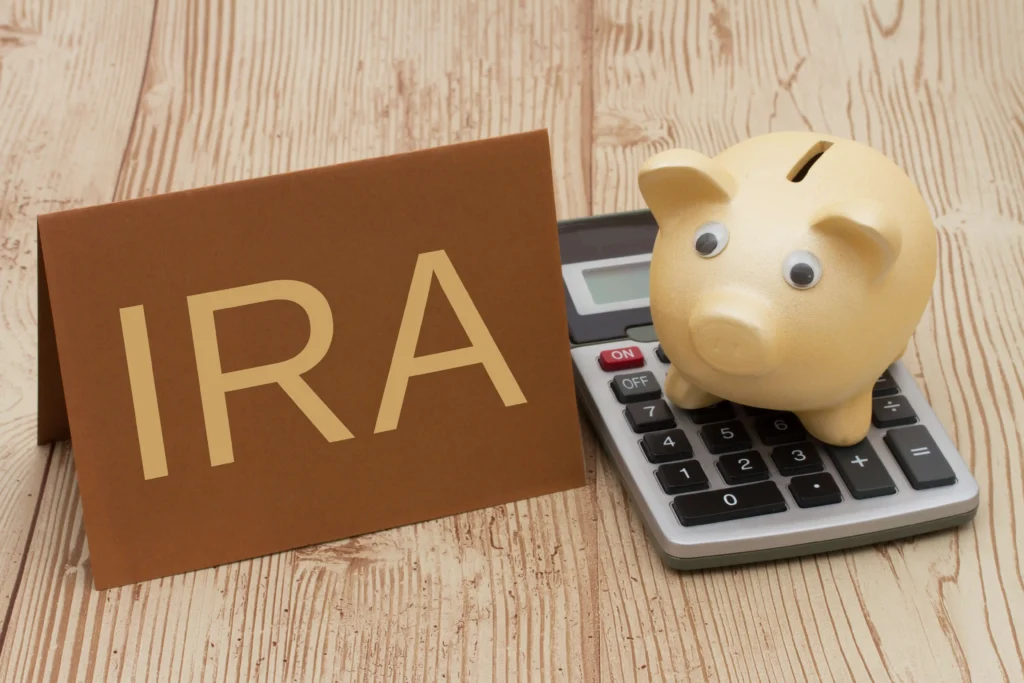IRA Accounts and Their Benefits are key for retirement savings. They offer tax-deferred growth, helping you make the most of your savings1. IRAs have tax advantages that boost your savings power1. With an IRA, you invest without paying taxes until you withdraw, helping your savings grow2.
IRAs help you save for retirement with tax benefits. We’ll explore their benefits, types, and rules. This will help you make smart choices for your retirement savings1. The 2023 IRA contribution limit is $6,500 for those under 50, and $7,500 for those 50 and older2.

Knowing IRA benefits and rules helps you make smart retirement savings choices. We’ll guide you through the IRA world, helping you maximize your retirement savings2.
What is an IRA Account?
An IRA, or Individual Retirement Account, is a savings account for retirement. It offers tax benefits3. There are different types, like traditional IRA, Roth IRA, and self-directed IRA. Each has its own features.
Traditional IRAs let you deduct contributions from your taxes. Roth IRAs grow tax-free and offer tax-free withdrawals in retirement4.
Choosing the right IRA is important. A traditional IRA is good if you’ll be in a lower tax bracket later. A Roth IRA is better if you’ll be in a higher tax bracket. Self-directed IRAs let you invest in more assets3.
When picking an IRA, consider these points:
- Contribution limits: In 2024, you can contribute up to $7,000 if you’re under 50. If you’re 50 or older, it’s $8,0003.
- Tax benefits: Traditional IRAs let you deduct contributions. Roth IRAs offer tax-free growth and withdrawals4.
- Investment options: Self-directed IRAs give you more investment choices, letting you diversify3.

Traditional IRA vs. Roth IRA
When thinking about retirement savings, we often compare traditional vs. Roth IRA. These IRAs differ in their tax benefits and rules. Traditional IRAs let you deduct contributions from your income, lowering your taxes. But, you’ll pay taxes on withdrawals5. Roth IRAs, on the other hand, grow tax-free and withdrawals are tax-free too. But, you can’t deduct contributions from your income6.
Choosing between them depends on your tax situation. Traditional IRAs are good if you think you’ll be in a lower tax bracket later. Roth IRAs are better if you expect to be in a higher tax bracket7. It’s important to think about this when picking an IRA for your retirement savings. The yearly contribution limit for IRAs is $7,000 in 2024, with an extra $1,000 for those 50 and older5. Roth IRA contributions have income limits, and the 2024 limit for Roth 401(k) contributions is $23,000, with a $7,500 catch-up7.
Here are some key points to consider when choosing between a traditional and Roth IRA:
- Traditional IRA contributions are tax-deductible, but withdrawals are taxed as ordinary income5.
- Roth IRA contributions are not tax-deductible, but qualified distributions are tax-free6.
- Traditional IRAs have required minimum distributions (RMDs) starting at age 73, while Roth IRAs do not have RMDs during the account owner’s lifetime7.
The right choice between a traditional and Roth IRA depends on your financial situation and retirement goals. It’s key to consider tax brackets, income limits, and contribution limits when deciding567.
| IRA Type | Contribution Limit | Tax Benefits |
|---|---|---|
| Traditional IRA | $7,000 (2024) | Tax-deductible contributions, taxed withdrawals |
| Roth IRA | $7,000 (2024) | Non-deductible contributions, tax-free distributions |

Contribution Limits and Rules
When you make contributions to an IRA, there are rules and maximum amounts to remember. For 2024, the maximum amount you can contribute is $7,000. If you’re 50 or older, you can contribute up to $8,000. Additionally, if you have an employer-sponsored IRA, different rules and maximums might apply. Understanding these amounts helps you maximize your savings.
The maximum contribution changes based on age and income. For example, in 2024, single individuals can contribute the full amount if their Modified Adjusted Gross Income (MAGI) is below $146,000. The MAGI phaseout range for singles is between $146,000 and $161,000. It’s crucial to keep these factors in mind when planning your contributions.
| Year | Contribution Limit | Catch-Up Contribution |
|---|---|---|
| 2024 | $7,000 | $1,000 |
| 2023 | $6,500 | $1,000 |
| 2022 | $6,000 | $1,000 |
Knowing the contribution limits and rules for IRAs helps you make smart choices for your retirement savings. It’s key to consider your personal situation and talk to a financial advisor if you need to8.

Tax Advantages of IRAs
Understanding the tax benefits of retirement accounts is key to smart retirement planning. These accounts allow your savings to grow without taxes until you withdraw them. Certain accounts let you withdraw money tax-free, which is especially beneficial for those who may be in higher tax brackets later on.
When planning for the future, it’s important to consider how taxes impact your investments. These accounts help you grow your savings without immediate tax concerns. For example, in 2024, you can deduct contributions to certain savings accounts if you make under $87,000 as a single filer or $143,000 as a married couple. Additionally, you can contribute up to $7,000, or $8,000 if you’re 50 or older.
Here are some IRA benefits to consider:
- Tax-deferred growth, allowing your savings to grow faster over time
- Tax-free withdrawals from Roth IRAs, providing a source of tax-free income in retirement
- Flexibility in investment options, allowing you to choose the investments that align with your retirement goals
By using these benefits, you can build a solid retirement plan. This plan will help you reach your financial goals11.

How to Open an IRA Account
Opening a retirement account is easy. You just need to choose a good financial institution and provide the necessary documents. Consider the types of accounts available, like traditional or Roth options. Also, pay attention to fees and the investment choices they offer. A self-directed account lets you select a wider range of investments, which is key for effective retirement planning.
Choosing the right institution is crucial. Pay attention to their minimum balance requirements, available investment choices, and fees. Many banks allow you to open an account with no initial deposit, making it easier to start planning for your future. They also provide a range of investment possibilities, such as stocks and bonds, which are ideal for self-directed accounts.
4o mini
To open an account, you’ll need to provide your social security number, proof of income, and ID. Make sure you understand the account’s rules, including any fees or penalties. By doing thorough research, you can select the right account type to help meet your retirement goals.

Investment Options Within IRAs
IRAs offer a variety of investment choices, like stocks, bonds, and mutual funds. These choices are known for their stable returns15. For those who want more flexibility, a self-directed retirement account is a great choice. It allows you to invest in various assets, such as real estate or alternative investments. Understanding these options is crucial to maximizing the potential of your retirement savings.
The type of investment you select can significantly impact your savings growth. For instance, traditional retirement account contributions are tax-deductible, meaning your earnings grow without being taxed until you withdraw them. On the other hand, withdrawals from Roth retirement accounts are tax-free in retirement, which is ideal for those who expect to be in a higher tax bracket later.
It’s also important to be aware of contribution limits and rules for these accounts. In 2024 and 2025, you can contribute up to $7,000 to a traditional retirement account. If you’re 50 or older, the limit increases to $8,000. Additionally, you must begin taking withdrawals by age 73. By adhering to these rules and selecting the right investments, you can ensure your retirement account works effectively for your financial goals.
IRA Rollovers and Transfers
Understanding IRA rollover Options is key. These transactions have rules and deadlines you must know. A rollover moves funds from one individual retirement account to another. A transfer moves funds from an employer plan to an IRA. Both are important for retirement planning as they help manage your savings18.
The rollover process can be tricky. Knowing the deadlines and tax implications is vital. For example, indirect rollovers must be done in 60 days to avoid taxes19. Also, you’ll get 20% less in your check due to taxes19.
Roth accounts require tax payments on rollovers, except from Roth 401(k)s. They allow tax-free withdrawals after age 59½ and five years of holding. In 2024 and 2025, you can contribute up to $7,000 ($8,000 if 50 or older) to these accounts. Understanding these rules is essential for making informed planning decisions for your future.
The Flexibility of IRAs: Making the Most of Your Account
One of the biggest advantages of IRA accounts is their flexibility. You can start small, contributing as little as you can, and increase your contributions as your income grows. This makes retirement accounts ideal for everyone, from young professionals to those nearing retirement.
A savings account also lets you decide how to invest your funds. Whether you prefer safer choices like bonds or want to take on more risk with stocks, these accounts allow you to create a personalized investment strategy. This flexibility is essential for growing wealth over time.
Additionally, these accounts can be used to fund more than just your future. If you’re considering real estate or other investment opportunities, a self-directed account offers that freedom. This is a great way to diversify your portfolio and enhance potential returns.
Another advantage is the ability to roll over other accounts, such as a 401(k), into your savings account. This gives you more control over your investments and simplifies your financial planning. By consolidating accounts, you can better manage your future and avoid missing out on opportunities.
In conclusion, a savings account offers a flexible and powerful approach to securing your financial future.. Whether you’re just beginning or nearing retirement, it helps make your money work harder for you. The key is to choose the right account type and contribute consistently to reap the full benefits.
Penalties and Withdrawal Rules
Withdrawing funds from individual retirement accounts comes with rules and penalties. There’s a 10% penalty and income tax on withdrawals21. But, there are exceptions like buying a first home or for education expenses.
Retirement account benefits are great, but knowing withdrawal rules is key. Withdrawing before 59 1/2 can mean a 10% penalty and income tax22. Yet, exceptions like disaster losses can let you withdraw up to $22,00021.
Some important exceptions to early withdrawal rules include:
- Qualified first-time homebuyers can withdraw up to $10,000 tax-free21
- Those using funds for education expenses22
- Domestic abuse victims can withdraw up to $10,000 or 50% of their balance21
It’s vital to know the early withdrawal rules and exceptions. This helps make smart choices about individual retirement accounts and enjoy the benefits22.
Questions About IRAs
When thinking about IRAs, we might wonder how they compare to 401(k)s23It’s important to understand the basics, like the different types, contribution limits, and tax benefits. For example, in 2024, you can contribute up to $7,000 to both traditional and Roth retirement accounts. If you’re 50 or older, you can contribute an extra $1,000.
When comparing these accounts to 401(k)s, tax benefits stand out. Retirement accounts allow your savings to grow without being taxed, helping them grow more efficiently. Roth accounts are especially beneficial because withdrawals are tax-free, making them a great choice if you expect to be in a higher tax bracket later.. Here’s a table to compare traditional and Roth IRAs:
| IRA Type | Contribution Limit | Tax Benefits |
|---|---|---|
| Traditional IRA | $7,000 (2024) | Tax-deductible contributions |
| Roth IRA | $7,000 (2024) | Tax-free withdrawals |
IRAs have rules, like penalties for early withdrawals and RMDs25. Yet, they’re a strong way to build wealth and secure our future, alongside other savings plans25. Knowing the pros and cons helps us make smart choices for our retirement.
For more info, check out online forums, talk to financial advisors, or visit educational sites23. By doing our homework, we can optimize our retirement savings and reach our financial dreams.
The Long-Term Benefits of IRAs
When thinking about long-term savings, these accounts are a key option. They help you build wealth over time, which is vital for your future. These accounts are special because they grow your savings without taxes, thanks to their tax-advantaged status.
They also bring peace of mind and financial security. Having a solid savings plan can make you feel more confident. It lets you enjoy your later years without worrying about money.. Both traditional and Roth IRAs offer great benefits, helping you reach your retirement dreams and live comfortably.
Conclusion: Take Action
IRAs provide a flexible and powerful way to secure your financial future. By choosing the right account type and understanding its benefits, you can build a solid foundation for retirement.
Contributing regularly to a retirement account, whether traditional or Roth, allows you to grow your savings with tax advantages. The ability to adjust contributions and investment strategies makes these accounts a valuable tool at every stage of life.
It’s essential to stay up-to-date on the latest rules and contribution limits to maximize the benefits of your retirement account. Whether you’re just beginning your savings journey or approaching retirement, making informed decisions today can lead to a more secure and comfortable future.
Start today and make your future brighter by taking advantage of the benefits IRA accounts offer. Don’t wait—your future self will thank you. Make this step now, and watch your savings grow.
Take Action!
FAQ – Frequently Asked Questions
What is an IRA account?
An IRA, or Individual Retirement Account, is a savings account for retirement. It offers tax benefits. There are different types, like traditional, Roth, and self-directed IRAs, each with its own features.
What are the main differences between a traditional IRA and a Roth IRA?
Traditional IRAs let you deduct contributions from your taxes, but you’ll pay taxes on withdrawals. Roth IRAs grow tax-free and withdrawals are tax-free, but contributions aren’t tax-deductible.
What are the contribution limits for an IRA?
In 2024, you can contribute up to ,000 to an IRA, or ,000 if you’re 50 or older. If you’re 50 or older, you can also make catch-up contributions. Contribution limits might change if you have an employer-sponsored IRA.
What are the tax advantages of IRAs?
IRAs offer tax-deferred growth, meaning you won’t pay taxes on earnings until you withdraw them. This can help your savings grow faster. Roth IRAs also offer tax-free withdrawals, providing tax-free income in retirement.
How do I open an IRA account?
Opening an IRA is easy. Choose a financial institution like a bank or brokerage firm. You’ll need your social security number, proof of income, and ID.
What investment options are available within an IRA?
IRAs let you invest in stocks, bonds, mutual funds, and more. Traditional IRAs have fewer options, but self-directed IRAs offer more flexibility.
What are the rules and penalties for withdrawing from an IRA?
Withdrawing before 59 1/2 may incur a 10% penalty and income tax. But, there are exceptions for first-time home purchases or education expenses.
How do IRA rollovers and transfers work?
Rollovers move funds between IRAs, while transfers move funds from employer plans to IRAs. Knowing the rules and tax implications is key.
Source: USA Today – Finance | Related articles: X – Twitter / Quora




